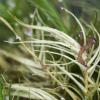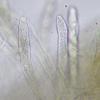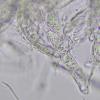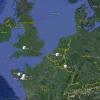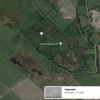
12-11-2025 09:25
 Viktorie Halasu
Viktorie Halasu
Hello, I need help with a pale terrestric Pseudom

11-11-2025 20:16
Bohan JiaHi, lastly I have found these tiny yellow decayin

09-11-2025 13:20
Hello.A tiny ascomycete, appearing as erupting gra

08-11-2025 00:29
 Francois Guay
Francois Guay
I found this species in Quebec, Canada, on herbace
Bryophylous fungus on Dicranella
Jannes Boers,
02-02-2022 20:36
Hi all,
Today I accidentally collected this species while taking some weakened Dicranella heteromalla. Therefore I only had the opportunity to study one ascocarp for now. Does someone perhaps know what this can be or where I have to look for a solution based on what I have so far?
Paraphyses seemed to be long filiform, slightly curved, 2 - 2,5 um wide, branched, aseptate.
Asci cylindrical to somewhat clavate, 8-spored 120 x 10 - 12 um, most of them immature unfortunately, spores uniseriately arranged.
Ascospores smooth, hyaline, ellipsoid, 20 - 22 x 9 - 10 um, and becoming 1-septated (?).
I know it is quite poor for now and hopefully I manage to collect some more of it in the near future.
Best wishes,
Jannes
Jean-Paul Priou,
02-02-2022 20:54

Re : Bryophylous fungus on Dicranella
Certainly Helotium fulva Boud. that will become Rutstroemia fulva.
Hans-Otto Baral,
02-02-2022 22:25

Re : Bryophylous fungus on Dicranella
What a big coincidence! A minute after I closed my manuscript about this species for today, I see this posting.
There is a publshed paper about it: De Meulder H. (1992). Helotium fulvum Boud., een bryofytische parasiet. – AMK Mededelingen 92.3: 79–82.
Since the species was not often collected, I would be glad to include your sample in my distribution map below.
How is the geology at the site, acidic? Is it soil or rock?
Zotto
Jannes Boers,
06-02-2022 22:38
Re : Bryophylous fungus on Dicranella
Thanks for your responses both and for the paper Zotto!
I collected this species on Dicranella, which grew on a vertical sandy wall, created by a tree that fell over. Another result because of this was stagnation of rain water at the bottom. This causes locally also higher humidity than other parts of the forest. Soil is sandy and acidic.
Jannes
Hans-Otto Baral,
07-02-2022 08:23

Re : Bryophylous fungus on Dicranella
Thank you very much, Jannes, this acidic environment matches other reports of the species.
Now, if you don't mind, could you tell me the coordinates or alternatively the approximate place on a map? Your abbreviation is J.J. Boers? 2x Jannes?
Zotto
Jannes Boers,
07-02-2022 12:14
Hans-Otto Baral,
07-02-2022 12:58

Re : Bryophylous fungus on Dicranella
Very good, thanks! This is Gelderland, or? No, I looked on a map, it is Groningen. The stipe of this apothecium is very long, do you have an idea of its length? So far 1.8 mm is the maximum.
Jannes Boers,
10-02-2022 20:51
Re : Bryophylous fungus on Dicranella
Hi Zotto, Unfortunately I have no measurements of the stipe.. Will keep that in mind for the next time.
Hans-Otto Baral,
10-02-2022 21:22

Re : Bryophylous fungus on Dicranella
o.k., I have just tried to compare your photo with other collections and arrive to the conclusion that the stipe is about 1.5 x 0.2 mm, which is almost maximum length that I recognized (1.8) and the and medium width (0.15-0.3 mm).

